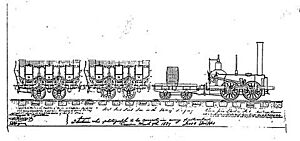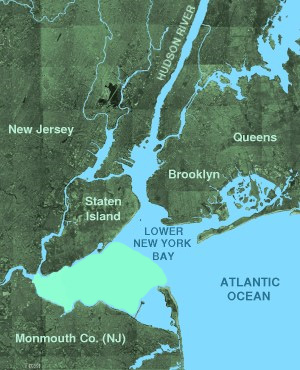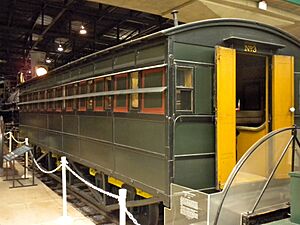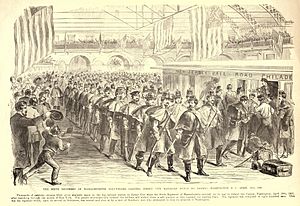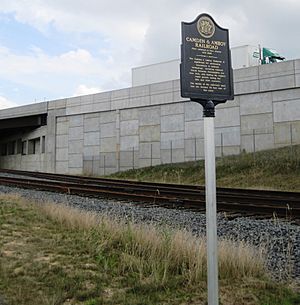United New Jersey Railroad and Canal Company facts for kids
| Overview | |
|---|---|
| Locale | New Jersey and Pennsylvania |
| Dates of operation | 1832–1976 |
| Successor | Amtrak, Conrail |
| Technical | |
| Track gauge | 4 ft 8 1⁄2 in (1,435 mm) standard gauge |
The United New Jersey Railroad and Canal Company (UNJ&CC) was an important railroad company. It started as the Camden & Amboy Railroad (C&A) in 1830. This made it one of the first railroads in North America.
The C&A was special because it focused on carrying passengers quickly. It wanted to compete with stagecoaches between New York and Philadelphia. Later, the UNJ&CC became part of the Pennsylvania Railroad (PRR) system in 1872. This included the main line to New York City, which is now Amtrak's Northeast Corridor.
The Camden and Amboy was the first railroad designed mainly for passengers. It was also the first to use steam locomotives instead of animal power. The C&A bought and used the John Bull, a steam locomotive from Great Britain in 1831. This locomotive is still the oldest working steam engine in the world today! The C&A also helped develop the iron T-rail tracks used worldwide.
The United Company also included the Delaware and Raritan Canal. This canal was first a rival, then a partner, to the C&A. Another part of the new company was the New Jersey Rail Road and Transportation Company. This was the first railroad to cross the New Jersey Palisades.
Contents
History of New Jersey's Early Railroads
The very first railroad permission in the United States was given on February 6, 1815. It was for the New Jersey Railroad Company. One of its owners was the famous inventor John Stevens. This early railroad planned to build between New Brunswick and Trenton. It became a model for future railroad plans.
In the early 1800s, traveling between New York and Philadelphia was hard. These were America's two biggest cities. A trip by horse could take 11 to 20 hours. Moving heavy goods by boat meant going all the way around Cape May, New Jersey.
In 1829, New Jersey wanted to make travel easier and cheaper. They looked into building a canal and railroads. Railroads were already successful in Britain. So, the state decided to build both a canal and a railroad. They were built side-by-side but by different companies. Each company had to give the state money and pay a tax on goods and passengers.
Camden and Amboy: New Jersey's First Railroad
The Camden & Amboy Rail Road and Transportation Company (C&A) was officially started on February 4, 1830. On the same day, the Delaware and Raritan Canal Company was also formed. These two companies had similar goals. They wanted to connect the Delaware River (near Philadelphia) with the Raritan River (for access to New York City). One would use a canal, the other a new railroad technology.
The D&R Canal was built west of the C&A. It went from Trenton northeast to New Brunswick. The C&A ran south from South Amboy (on Raritan Bay) to Camden. From Camden, people would take a ferry across the Delaware River to Philadelphia. These routes linked New York and Philadelphia much faster than before.
Robert L. Stevens was the president of the C&A in its early years. Construction of the C&A began on December 4, 1830, in Bordentown. Since railroads were new in the U.S., tracks and engines came from Britain.
The John Bull locomotive arrived in Bordentown on September 4, 1831. It was first tested on November 12. The first part of the line opened on October 1, 1832. This section went from Stewarts Point Wharf to Hightstown. At first, horses pulled the trains.
Travel between Philadelphia and Stewarts Point Wharf was by steamboat. A stagecoach connected Hightstown and South Amboy. The full trip cost $3 and took about 9.5 hours. This was 1-2 hours faster than other ways to travel. The rest of the line to South Amboy opened on December 17, 1832. This removed the need for a stagecoach. Freight service started on January 24, 1833. The John Bull began regular use on September 9, 1833.
In late 1833, an accident happened where some passengers were hurt. This was an early train accident involving passengers. The line was extended south to Delanco in fall 1833. The full line to Camden was finished on December 19, 1834. The C&A quickly became profitable.
New Jersey Rail Road: Connecting to Jersey City
On March 7, 1832, the New Jersey Rail Road and Transportation Company (NJRR) was formed. It was meant to be a parallel line to the C&A. It started in Jersey City, which was closer to New York City. The C&A's influence limited the NJRR to building south only to New Brunswick. The C&A would build the part from New Brunswick south to Trenton.
The NJRR bought control of the Essex and Middlesex Turnpike in November 1832. This turnpike ran south from Newark to New Brunswick. Most of the railroad was built right along this turnpike.
Regular NJRR service began on September 15, 1834. It ran between Newark and Jersey City. An extension to Elizabeth opened on December 21, 1835. Service to Rahway began on January 1, 1836. The line opened to New Brunswick on July 11, 1837.
On October 31, 1837, a double-deck bridge over the Raritan River opened. This brought the NJRR into New Brunswick. The railroad was on the top level, and a road was below. The last part of the Jersey City–New Brunswick line, the Bergen Hill Cut, opened on January 22, 1838. This finished the main line and ended the use of horses.
A new branch of the C&A was built from Bordentown to Trenton. It opened on April 4, 1838. The extension from Trenton to New Brunswick opened on January 1, 1839. This completed the connection between Philadelphia and New York City. The trip now took about 5.5 hours.
More Connections and Changes
By 1839, a connection opened between the Philadelphia & Trenton Railroad and the C&A's Trenton Branch. This included a bridge over the D&R Canal in Trenton. This allowed trains to run directly between Philadelphia and Jersey City.
In 1854, the C&A decided to make its Trenton Branch straighter. This new route bypassed Princeton. A new station in Trenton opened on April 20, 1863. The new line, which is now part of the Northeast Corridor, opened on November 23, 1863. This cut the New York City–Trenton travel time to 2.5 hours. The Princeton Branch opened on May 29, 1865.
Railroad Competition and Mergers
Other railroads also used the NJRR's tracks to reach Jersey City. The Paterson and Hudson River Railroad (later part of the Erie Railroad) started using the NJRR's Bergen Hill Cut in 1834. The Morris and Essex Railroad (later part of the Delaware, Lackawanna and Western Railroad) also used the NJRR from Newark to Jersey City starting in 1836. The Central Railroad of New Jersey (CNJ) used the NJRR until its own line opened in 1864.
The C&A often tried to keep its special right to be the only railroad for New York City-Philadelphia travel. This special right finally ended on May 1, 1876.
On February 15, 1831, the C&A and D&R Canal companies joined together. They were called the Joint Companies. They made all big decisions together. In 1832, a law was passed that gave the Joint Companies a special right to control New York City-Philadelphia traffic across New Jersey. This right was extended until 1869.
In 1835, Robert F. Stockton bought control of the Trenton Delaware Bridge and Philadelphia and Trenton Railroad. This stopped their competition with the C&A. The three companies agreed to work together.
In 1862, a new competing line started operating. This made the C&A and NJRR work more closely. They signed an agreement on October 1. Another major competitor, the Newark and New York Railroad, opened in 1869.
On February 1, 1867, the C&A and NJRR informally joined. They became the United New Jersey Railroad and Canal Companies (UNJ). The Pennsylvania Railroad (PRR) agreed to lease the UNJ in 1871. On May 18, 1872, the C&A, D&R Canal, and NJRR officially combined. They formed the United New Jersey Railroad and Canal Company.
The new company was divided into two parts:
- The New York Division included the NJRR and the C&A Trenton Branch.
- The Amboy Division was the original C&A main line.
In 1968, the PRR merged with the New York Central Railroad to form the Penn Central. Due to financial problems, the Penn Central went bankrupt in 1970. It operated under court supervision until 1976. Then, the Northeast Corridor rail line went to Amtrak for passenger service. The remaining lines went to Conrail. Later, in 1979, New Jersey Transit took over the commuter rail lines.
Other Important Branches
The United New Jersey Railroad and Canal Company also controlled or leased several other important branch lines over the years. These lines helped expand its network across New Jersey. Some examples include:
- The Burlington and Mount Holly Railroad and Transportation Company, which opened in 1849.
- The Belvidere Delaware Railroad, which ran north from Trenton.
- The Freehold and Jamesburg Agricultural Railroad, connecting to the main line at Jamesburg.
- The Perth Amboy and Woodbridge Railroad, which opened in 1864.
- The Rocky Hill Railroad and Transportation Company, a branch from Kingston.
What Remains Today
Today, parts of the original C&A lines are still in use. The original C&A path and the Trenton Branch are now part of New Jersey Transit's RiverLINE. This is a modern light rail line. Freight trains still use these tracks at night.
The rest of the Trenton Branch is part of Amtrak's busy Northeast Corridor. This is a major passenger rail line.
The original line from Bordentown north to Robbinsville is used by Conrail Shared Assets. The Princeton Branch is still used by New Jersey Transit for passengers.
Many of these historic rail paths continue to serve New Jersey today. They are a reminder of the state's important role in early American railroad history.



